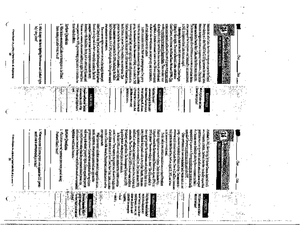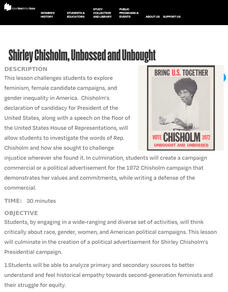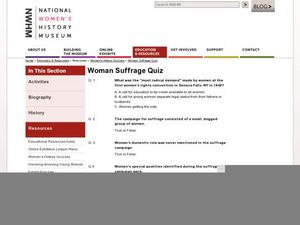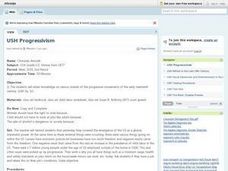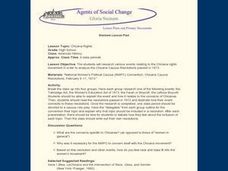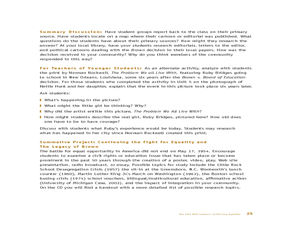National Woman's History Museum
Gloria Steinem, Feminism and “Living the Revolution"
Excerpts from Feminine Mystique by Betty Friedan and from Gloria Steinem's "Living the Revolution" provide high schoolers an opportunity to study the feminism of the 1950s and 1960s, sometimes called the "Second Wave of Feminism."
Daughters of the American Revolution
Lesson 1: How Do Society’s Expectations Influence Education?
The history of women's education can be traced back to the delicate stitching of student samplers from the 19th century. Modern-day pupils examine and analyze four primary sources, three of which are images of embroidered samplers, which...
EngageNY
Grade 11 ELA Module 2: Unit 2, Lesson 8
Using the resource, pupils consider how the author structures her argument in "An Address by Elizabeth Cady Stanton." Scholars complete a written response to identify one of Cady Stanton's claims and analyze how she uses reasoning and...
A Mighty Girl
Maria da Penha
A colorful poster introduces class members to Maria da Penha. A biopharmacist and activist, Penha was influential in writing and getting passed, Brazil's first domestic violence law which bears her name.
Curated OER
Counterculture, Women's Movement, and the Environmental Movement
In this contemporary U. S. history worksheet, students read articles about the counterculture, Women's Movement, and the Environmental Movement. Students then respond to 19 short answer questions.
National Woman's History Museum
Shirley Chisholm, Unbossed and Unbought
An engaging resource introduces young historians to Shirley Chisholm, the woman, the Black congresswoman, the activist, and the candidate for President in 1972. Class members study primary sources, watch a video of her announcing her run...
National Woman's History Museum
Dolores Huerta and the Delano Grape Strike
Few have heard of Dolores Huerta and her part in organizing the California farm workers, establishing the United Farm Workers union and orchestrating the Delano Grape strike. High schoolers consider why this powerful woman has been...
Curated OER
Woman Suffrage Quiz
What does your class know about the women's suffrage movement? Can they name the patron saint of this movement? Or can they explain why babies were used in the suffrage campaigns? Do they know what the most radical demand was? If so,...
Curated OER
What is Suffrage? Understanding the Right to Vote
Students discover one of the restrictions forced on women of the early 1900s. In this civil rights lesson, students investigate suffrage and why women were not allowed to vote in the early twentieth century. Students create a mock...
Curated OER
The Anti-Slavery Movement
Eleventh graders as a class create and write a constitution for an anti-slavery society. They investigate demographics of slavery, treatment of slaves, the colonization movement, and women in the abolition movement, and present their...
Curated OER
USH Progressivism
Eleventh graders explore, analyze and interpret various strands of the progressive movements of the early twentieth century. They cover the background of child labor laws, Susan B. Anthony's 1873 court speech and alcohol issues in the...
Curated OER
Temperance Alphabet
Students research the Temperance Movement and create a persuasive project. In this Temperance/Prohibition Movement lesson, students research online and discuss the arguments for the movement. Students read a pamphlet and create an...
Curated OER
Chicana Rights
Students research various events relating to the Chicana rights movement in order to analyze the Chicana Caucus Resolutions passed in 1973.
Curated OER
The Past Half Century: Achieving Equality
Students analyze reactions to the Brown vs. Education decision of 1954. In this segregation instructional activity, student look at the actions that were taken in the education world as a result of the Brown decision. They watch a CD,...
Facing History and Ourselves
The Audacity of a Vote: Susan B. Anthony’s Arrest
Susan B. Anthony's speech "Is It a Crime for Women to Vote?" takes center stage in a lesson that asks class members to consider how they might respond to what they consider an unjust law. Groups work through the speech paragraph by...
National Endowment for the Humanities
Kate Chopin's The Awakening: Local Color in the Late 19th Century
Kate Chopin's The Awakening introduces readers not only to the lush Louisiana setting of Grand isle but also to the nuances of Creole culture. the second lesson in a three-part series examines how Chopin's use of literary realism and...
Curated OER
Who Is Sarah Mae Fleming?
Fifth graders learn about two influential women. In this historical figures lesson, 5th graders work in groups to read articles about Rosa Parks and Sarah Fleming and share their findings with the class. Students use a Venn Diagram to...
Curated OER
Rosa Parks Refused to Do What?
First graders listen to two books about Rosa Parks. They contribute factual information for a web. They listen to an interview with Rosa Parks on the internet, adding more information to the web. They write and illustrate a book using...
National Woman's History Museum
Ida B. Wells: Suffragist and Anti-Lynching Activist
Suffragette, investigative journalist, and civil rights activist Ida B. Wells is the focus of a lesson that has young historians study the work of this amazing woman. Scholars watch a video biography of Wells, read the text of her speech...
National Woman's History Museum
Helen Keller--Citizen and Socialist
Do history books tell the full story of Helen Keller? The sanitized version of Helen Keller found in most textbooks leaves out her most provocative ideas. She was a socialist, fought for workers' rights, and advocated for the use of...
Curated OER
Reformers
Students research reform efforts during the 1800's, primarily those leading up to the Civil War. They complete several lessons that investigate the life of Sojourner Truth and her contributions to the abolitionist movement and women's...
Curated OER
The Sixties Protests and Social Change
Students identify, examine and analyze photographs of the sixties to determine the forces of social change at work in America during this decade. They determine the goals of each movement and the methods used by each to achieve those goals.
Intersectional Black Panther Party History Project, IPHP
Teaching the History of the Black Panther Party: 5 Essential FAQ’s
What are the facts about the Black Panther Party? Was it, as J. Edgar Hoover contended, a terrorist organization and a threat to national security? Or a group of indviduals bound together by a desire to protect and nurture their...
US House of Representatives
Congresswomen in an Age of National Crises, 1935–1954
Class members investigate congresswomen and the role these senators and representatives played in congress during the period from 1935–1954.
Other popular searches
- Early Women's Rights Movement
- Women's Rights Movement 1800
- Womens Rights Movement 1960s
- Womens Rights Movement 1800
- Early Womens Rights Movement
- The Women's Rights Movement






